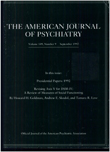Efficacy of behavioral versus triazolam treatment in persistent sleep- onset insomnia
Abstract
OBJECTIVE: This study compared differential effects of behavioral therapy and triazolam in a clinical population with sleep-onset insomnia. Triazolam was hypothesized to decrease sleep latency and frequency and duration of awakening, with some effects during the first night's administration. But at follow-up, sleep measures were predicted to return to baseline levels. Behavioral treatment was hypothesized to effect sleep after 2 or more weeks of training which persisted at follow-up. METHOD: Thirty patients with average sleep latencies of 81.48 minutes, who reported chronic insomnia for an average of 2.6 years, were randomly assigned to one of two treatment groups: behavioral stimulus control/relaxation training and triazolam. RESULTS: Both treatments decreased sleep latency but differentially. Triazolam was effective immediately but maintained only some gains at follow-up. Behavioral treatment decreased sleep latency beginning the second week, when subjects expected no improvement, with gains maintained at follow- up. Comparisons showed that triazolam group latencies returned toward baseline, while behavioral group gains were maintained at follow-up. CONCLUSIONS: Triazolam treatment showed superior immediate treatment effects, while behavioral treatment showed superior treatment effects at follow-up, effects that accrued during the training period and differentially persisted at follow-up. One treatment strategy implied by these results would be to combine these two interventions concurrently. This would seem to use the immediate effects produced by the medication until the behavioral skills were learned, at which point medication would be terminated. This strategy could offer immediate relief and sustained effects at drug termination.
Access content
To read the fulltext, please use one of the options below to sign in or purchase access.- Personal login
- Institutional Login
- Sign in via OpenAthens
- Register for access
-
Please login/register if you wish to pair your device and check access availability.
Not a subscriber?
PsychiatryOnline subscription options offer access to the DSM-5 library, books, journals, CME, and patient resources. This all-in-one virtual library provides psychiatrists and mental health professionals with key resources for diagnosis, treatment, research, and professional development.
Need more help? PsychiatryOnline Customer Service may be reached by emailing [email protected] or by calling 800-368-5777 (in the U.S.) or 703-907-7322 (outside the U.S.).



